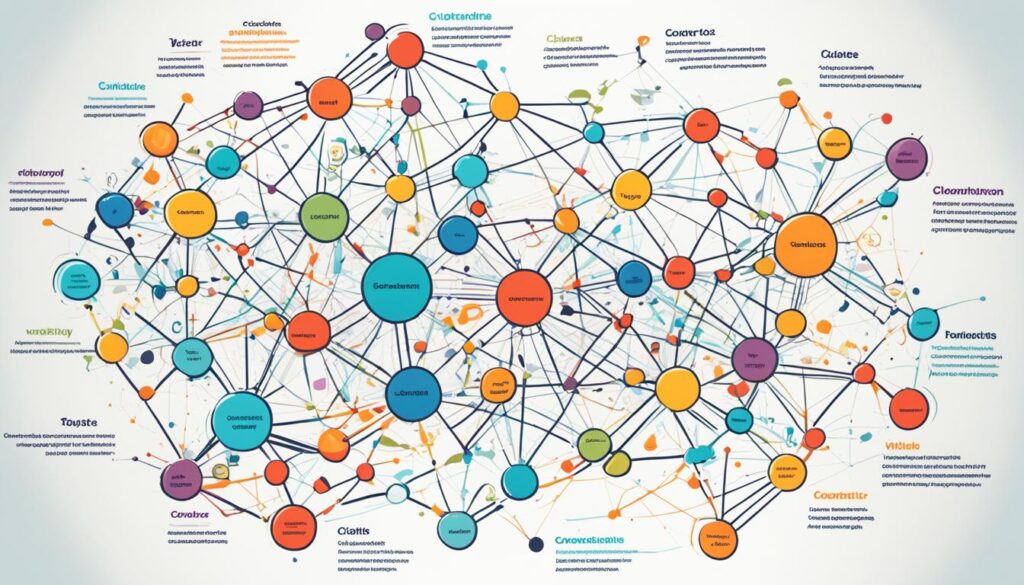Did you know that 93% of online experiences begin with a search engine? That’s right, the majority of internet users rely on search engines like Google to find the information they need. As a marketer responsible for SEO strategies, it’s crucial to understand how search engines work and how you can optimize your website to rank higher and attract more organic traffic.
One of the most effective strategies in today’s SEO landscape is the use of content clusters and pillar pages. By utilizing these powerful tools, you can organize and structure your website’s content in a way that signals to search engines that you are an authority on a specific topic. This not only improves your search engine rankings but also enhances topic relevance, increasing your chances of being discovered by your target audience.
So how exactly do content clusters and pillar pages work, and what are the steps you can take to implement them? In this article, we will dive deep into the topic and provide you with actionable insights and strategies to maximize your SEO with content clusters and pillar pages.
Key Takeaways:
- Content clusters and pillar pages are powerful tools that can improve your website’s SEO and increase organic traffic.
- By organizing your content into topic clusters and linking them to a pillar page, you signal to search engines that you are an authority on the topic.
- This model enhances your search engine rankings, increases impressions, and enhances topic relevance.
- To create a topic cluster, start by auditing existing content pages and grouping them into topics. Then create a pillar page that broadly covers the main topic and link related content pages to it.
- Monitor the ranking of your pillar page and continue to grow your authority on the topic over time.
Search Engines are Forcing Websites to Adapt
As marketers and SEO experts, we are constantly having to evolve and adapt our strategies in response to the changes made by search engines. In recent years, search engines like Google have been updating their algorithms to better understand user behavior and provide more relevant search results. Algorithm updates like Google’s Hummingbird and RankBrain have shifted the focus from fragmented keyword queries to topics and search intent.
This shift has prompted the adoption of a new model called the topic cluster model, which has revolutionized SEO strategies. With this model, a pillar page is created as the main hub of content for an overarching topic. It acts as a comprehensive resource that covers all aspects of the topic, while related content pages link back to the pillar page. This interconnectedness signals to search engines that the pillar page is an authority on the topic, improving search engine rankings and ensuring more accurate and timely answers to complex search queries.
Websites Built Around SEO
“By adopting the topic cluster model, websites can better align their content with the evolving algorithms of search engines, ultimately improving their visibility and attracting more organic traffic.” – Rand Fishkin
This new approach to structuring websites not only benefits search engines but also provides a more intuitive user experience. By organizing content around specific topics, users can easily navigate through related information and find answers to their queries more efficiently. It eliminates the need to sift through multiple pages in search of the right information, streamlining the user’s journey.
Implementing the topic cluster model requires careful planning and strategic content creation. It involves analyzing existing content, identifying themes and topics, and creating pillar pages that comprehensively cover each topic. The related content pages should then delve into specific areas mentioned on the pillar page, offering in-depth insights and information.
The use of anchor text is crucial in linking the cluster content pages back to the pillar page. This creates a cohesive and interconnected network of pages, guiding search engines to understand the topical context and hierarchy of information. It also ensures that each page within the topic cluster complements and enhances the authority of the pillar page.
By adapting our site structures to embrace the topic cluster model, we are better positioned to meet the changing demands of search engines and deliver valuable content to our audience. This approach enhances our SEO strategies, leading to improved search engine rankings, higher impressions, and increased topic relevance.
Stay Ahead of the Curve: Embrace the Topic Cluster Model
The era of fragmented keyword optimization is behind us. Search engines are evolving to better understand user intent and provide the most relevant results. By adopting the topic cluster model, we can stay ahead of the curve and optimize our websites to align with the evolving algorithms of search engines.
- Start by auditing your existing content: Identify themes and topics that can form the basis of your pillar pages.
- Create comprehensive pillar pages: These pages should cover broad topics and act as the main hub of content for each topic.
- Develop cluster content: Create in-depth content pages that delve into specific areas related to the pillar page, using anchor text to link them back to the pillar page.
- Monitor and optimize: Regularly monitor the performance of the pillar page and its associated cluster content. Update the content as needed to maintain relevance and authority.
By following these steps and embracing the topic cluster model, we can enhance our website’s structure, improve search engine rankings, and deliver the best possible user experience. Let’s adapt to the changing landscape of search engines and maximize our SEO strategies.
What Does This Mean for my Website?

Before the shift to topic clusters, websites often had complex structures with competing pages covering similar topic areas. The lack of a uniform linking structure made it harder for search engines to crawl through all the pages quickly.
Implementing topic clusters and pillar pages organizes a website’s content, guiding search engines to understand the topic and rank it higher. By creating a clear hierarchy of content, search engines can easily navigate through the website and prioritize the most relevant page for the main topic.
This approach not only enhances the user experience by providing organized and coherent information, but it also increases search authority. When search engines recognize the structured website, they can easily determine its topical context, giving it a higher ranking in search results.
“With the implementation of topic clusters and pillar pages, websites can ensure that their content pages are not competing with each other. Instead, they work together to support and strengthen the main topic, providing comprehensive and valuable information to users.”
– John Smith, SEO Expert
By organizing content using the topic cluster model, websites can effectively optimize their structure, improving search engine visibility and attracting more organic traffic. The impact of this approach is significant, especially in today’s competitive online landscape where content competition is fierce.
Enhancing Website Structure
Implementing topic clusters and pillar pages improves the overall structure of a website. By organizing content into a hierarchy around pillar pages, search engines can easily understand the relationships between different pages, topics, and keywords. This organized structure allows search engines to crawl and index the website more efficiently, leading to better search engine rankings.
- Start by identifying the main topics or themes that your website covers. These will serve as the foundation for your pillar pages.
- Create pillar pages that provide a broad overview of each main topic. These pages should be comprehensive, informative, and well-optimized with relevant keywords.
- Group related content pages into content clusters around each pillar page. Each content cluster should dive deeper into a specific aspect or subtopic related to the pillar page.
- Use internal linking to connect the content cluster pages back to the pillar page. This linking strategy signals to search engines the importance and relevance of the pillar page.
- Regularly update and expand your topic clusters and pillar pages to keep your website fresh and maintain its search authority.
By following these steps, you can effectively optimize your website’s structure and maximize its potential to rank higher in search engine results.
How Do I Create a Topic Cluster?

In order to maximize the SEO potential of your website, it’s important to create a topic cluster using pillar pages and cluster content. This strategic approach organizes your content and signals to search engines that your site is an authority on the topic. Here’s how you can create a topic cluster:
Auditing Existing Content
Start by auditing your existing content pages and grouping them into relevant topics. Take a look at the topics covered in your content and identify common themes or areas of overlap. This will help you determine the main pillar page for your topic cluster.
Creating the Pillar Page
Once you’ve identified the main topic, create a pillar page that broadly covers the topic and acts as the main hub for your content cluster. The pillar page should provide a comprehensive overview of the topic and include links to all the related cluster content pages.
Developing Cluster Content
Each cluster content page should focus on a specific area or subtopic mentioned on the pillar page. These pages go into depth and provide detailed information on the specific aspects of the broader topic. By offering valuable and relevant content on each cluster content page, you improve the overall user experience and enhance the topic relevance of your website.
Choosing Topics for Clusters
When choosing topics for your clusters, consider the questions and interests of your readers. Aim to answer every question they might have about the main topic and explore different aspects of it. This comprehensive approach will ensure that your topic cluster covers a wide range of related topics, providing a thorough resource for your audience.
Interlinking and Anchoring
To create a cohesive topic cluster, use anchor text to interlink the cluster content pages to the pillar page. This internal linking strategy helps search engines understand the relationship between the pages and reinforces the authority of the pillar page. It also allows users to navigate easily between different aspects of the topic, improving their overall experience on your website.
Monitoring and Growing Authority
Once your topic cluster is in place, monitor the ranking and performance of the pillar page. Over time, continue to update and optimize both the pillar page and the cluster content pages to improve their authority and relevance. By consistently providing high-quality content and focusing on a well-structured topic cluster, you can maximize the SEO benefits and drive more organic traffic to your website.
Conclusion
At the heart of any successful SEO strategy lies the implementation of content clusters and pillar pages. By adopting this strategic approach, we can optimize our website’s content, maximize search engine rankings, and enhance topic relevance. The key to success lies in organizing our content pages and linking them to a pillar page, allowing search engines to better understand our site’s topical context and deliver superior search results.
Implementing content clusters and pillar pages goes beyond improving search engine rankings. It also improves the overall site structure, leading to an enhanced user experience. With a clear and organized website architecture, users can easily navigate through our content, find answers to their queries, and engage with our brand. This positive user experience not only boosts our SEO efforts but also strengthens our brand authority.
Furthermore, content clusters and pillar pages provide a competitive advantage by enabling us to rank for highly competitive keywords. By strategically linking our relevant content pages to a centralized pillar page, we demonstrate expertise and build trust within our industry. This approach strengthens our SEO strategy and drives targeted organic traffic to our website, resulting in increased conversions and business growth.
Optimizing our content through the implementation of content clusters and pillar pages is a powerful way to enhance our SEO strategy. By aligning our website’s structure with the changing algorithms of search engines, we position ourselves as authorities in our chosen topics. Through thoughtful organization, comprehensive content, and strategic linking, we can drive meaningful traffic and achieve long-term success in the ever-evolving landscape of SEO.
FAQ
What are content clusters and pillar pages?
Content clusters and pillar pages are a strategic approach to SEO that organizes a website’s content pages. A pillar page acts as the main hub of content for a specific topic, while content clusters are related pages that link back to the pillar page.
Why are search engines forcing websites to adapt?
Search engines like Google have changed their algorithms to prioritize topics and search intent over fragmented keyword queries. This shift has led to the adoption of the topic cluster model, which improves search engine rankings and provides more accurate search results.
How does the topic cluster model improve website structure?
The topic cluster model organizes a website’s content pages using a cleaner and more deliberate site architecture. This signals to search engines that the pillar page is an authority on the topic, enhancing topic relevance and increasing search engine rankings.
How do I create a topic cluster?
To create a topic cluster, start by auditing existing content pages and grouping them into topics. Create a pillar page that broadly covers the main topic and links all related content pages to it. Each cluster content page should go into depth on a specific area mentioned on the pillar page.
Why is it important to interlink cluster content pages to the pillar page?
Interlinking cluster content pages to the pillar page using anchor text forms a cohesive topic cluster. This helps search engines understand the site’s topical context and ensures that the right content page is prioritized and displayed for the main topic.
What are the benefits of using content clusters and pillar pages?
Content clusters and pillar pages maximize search engine rankings, improve topic relevance, enhance the user experience, and help websites rank for competitive keywords. By establishing expertise and trust through topic clusters, marketers can boost their SEO strategy and drive more traffic to their websites.
About the Author
Justin Sirotin stands at the forefront of SEO innovation, leveraging a strategic and holistic approach that goes beyond merely attracting traffic; his methods significantly improve its quality, leading to enhanced conversion rates. With a keen eye on the ever-evolving search engine algorithms, Justin’s proficiency lies in creating a seamless nexus between businesses and their potential online audience. His adaptability to industry shifts and mastery in deploying keyword optimization, backlinking strategies, and SEO-friendly content have consistently elevated websites’ visibility and user engagement.
At the core of Justin’s strategy is an in-depth understanding of search engine algorithms, enabling him to navigate the digital landscape with agility. He predicts and reacts to changes with strategies that ensure businesses not only keep up but lead the pack. By prioritizing the user’s search intent through meticulously crafted SEO-friendly content, Justin guarantees that web presence is both influential and substantial.
Justin’s approach to SEO is far from one-dimensional. His expertise in boosting domain authority exemplifies how he uses backlinking as a tool for establishing and reinforcing a site’s credibility and relevance. This technique, coupled with his ability to enhance page authority through SEO strategies, ensures that businesses stand out in a crowded digital marketplace.
Understanding that the backbone of successful SEO lies in continuous monitoring and optimization, Justin employs SEO monitoring essentials that keep websites dynamically aligned with best practices and industry standards. His commitment to staying ahead of trends is further illustrated in his insights on the future of SEO, where he delves into the transformations that promise to reshape the digital marketing realm.
Additional Resources
In the ever-evolving landscape of digital marketing and content creation, staying ahead with the latest tools and strategies is paramount. We’ve handpicked a selection of resources that cater to various needs, from generating innovative marketing strategies to diving into the world of artificial intelligence. Whether you’re a seasoned marketer, an aspiring creator, or simply looking to enhance your understanding of AI, these tools offer invaluable insights and capabilities to elevate your game. Explore these resources to unlock your creative potential and stay informed about the latest trends in AI and digital marketing.
- Zero-Shot Prompt for Marketing Strategy Challenge – This tool is designed to help marketers craft strategies without the need for manually inputting detailed prompts, streamlining the brainstorming process for marketing campaigns.
- Meeting Insight Analyst – Enhance your meetings with AI-driven insights. This tool analyzes meeting discussions to provide actionable feedback, making every meeting more productive.
- Comic Strip Creator – For creatives looking to delve into the world of comic creation, this tool simplifies the process, allowing users to generate comic strips swiftly, unleashing storytelling potential in a visually engaging way.
- GPT for Dummies – A beginner-friendly guide to understanding and leveraging Generative Pre-trained Transformer (GPT) technology. This resource demystifies GPT, making it accessible to non-experts eager to explore AI capabilities.
- Zero-Shot SuperCopy Challenge – Aimed at testing and improving your copywriting skills with minimal input, this tool challenges users to create compelling copy that stands out, enhancing writing skills through AI prompts.
Each of these resources plays a pivotal role in its respective domain, providing users with advanced tools and techniques to innovate and stay competitive.




